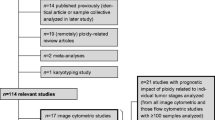Abstract
To assess the prognostic value of DNA ploidy in colorectal cancer, compared with the histopathological findings, paraffin-embedded surgical specimens from 330 patients who underwent resection for primary adenocarcinoma were studied using a new modified method of flow cytometry. Of these specimens, 141 were DNA diploid and 189, DNA aneuploid, among which there were 3 DNA hypodiploid lesions. Of the ten variables studied in curative resection, DNA ploidy ranked fourth in prognostic significance according to the linear trend by the χ2 test, after nodal status, grade of cellular differentiation, and degree of invasive growth, if the DNA ploidy pattern was classified into three categories. Conversely, DNA ploidy was the sixth most significant factor if DNA hypodiploidy was included in the DNA aneuploidy. The Cox multivariate analysis showed that DNA ploidy was one of the five significant factors independently determining prognosis; however, if adjustment for the modified Dukes' stage was made by the Mantel-Haenszel test, the survival difference between the diploid and aneuploid groups did not reach a statistically significant level. Thus, we conclude that from a practical point of view, DNA ploidy is not an essential factor which must be combined with histopathological variables for a better prediction of patient outcome.
Similar content being viewed by others
References
Hedley DW (1989) Flow cytometry using paraffin-embedded tissue: Five years on. Cytometry 10:229–241
Armitage NC, Robins RA, Evans DF, Turner DR, Baldwin RW, Hardcastle JD (1985) The influence of tumour cell DNA abnormalities on survival in colorectal cancer. Br J Surg 72:828–830
Kokal W, Sheibani K, Terz J, Harada R (1986) Tumor DNA content in the prognosis of colorectal carcinoma. JAMA 255: 3123–3127
Scott NA, Weiland HS, Moertel CG, Cha SS, Beart RW, Lieber MM (1987) Colorectal cancer, Dukes' stage, tumor site, preoperative plasma CEA level, and patient prognosis related to tumor DNA ploidy pattern. Arch Surg 122:1375–1379
Hedley DW, Friedlander ML, Taylor IW, Rugg CA, Musgrove EA (1984) DNA flow cytometry of paraffin-embedded tissue. Cytometry 5:660
Vindeløv LL, Christensen IJ, Nissen NI (1983) A detergenttrypsin 1 method for the preparation of nuclei for flow cytometric DNA analysis. Cytometry 3:323–327
Sickle-Santanello BJ, Farrar WB, DeCenzo JF, Keyhani-Rofagha S, Mein J, Pearl D, Laufman H, Otoole RV (1988) Technical and statistical improvements for flow cytometric DNA analysis of paraffin-embedded tissue. Cytometry 9:594–599
Mantel N (1963) Chi-square tests with one-degree of freedom: Extensions of the Mantel-Haenszel procedure. J Amer Stat Assoc 58:690–700
Pete R, Pike MC, Armitage P, Breslow NE, Cox DR, Howard SV, Mantel N, McPherson K, Peto J, Smith PG (1977) Design and analysis of randomized clinical trial requiring prolonged observation of each patient. Analysis of examples. Br J Cancer 35:1–39
Cox DR (1972) Regression models and life tables. J Roy Stat Soc B 34:187–220
Akaike H (1973) Information theory and an extension of the maximum likelihood principle. In: Petrov BN, Csaki F (eds) Second international symposium on information theory. Akademiai Kiado, Budapest, pp 1033–1055
Akaike H (1974) A new look at the statistical model identification. IEEE Trans Autom Contr AC-19:716–723
Turnbull RB Jr, Kyle K, Watson FR, Spratt J (1967) Cancer of the colon: The influence of the no-touch isolation technique on survival rate. Ann Surg 166:420–427
Hedley DW, Friedlander ML, Tayler IW, Rugg CA, Musgrove EA (1983) Method for analysis of cellular DNA content of paraffin-embedded pathological material using flow cytometry. J Histochem Cytochem 31:1333–1335
Shutte B, Reynders MMJ, Bosman FT, Blijham GH (1985) Flow cytometric determination of DNA ploidy level in nuclei isolated from paraffin-embedded tissue. Cytometry 6:26–30
van Driel-Kulker AMJ, Mesker WE, van Velzzen I, Tanke HJ, Feichtinger TJ, Ploem JS (1985) Preparation of monolayer smears from paraffin-embedded tissue for image cytometry. Cytometry 6:268–272
Oud PS, Hanselaar TGJM, Reubsaet-Veldhuizen JAM, Meijer JWR, Gemmink AH, Pahlplatz MMM, Beck HLM, Vooijs GP (1986) Extraction of nuclei from selected regions in paraffinembedded tissue. Cytometry 7:595–600
Morgan RJ, Gonchoroff JNJ, Katzmann JA, Witzig TE, Kyle RA, Greipp PR (1989) Detection of hypodiploidy using multiparameter flow cytometric analysis: A prognostic indicator in multiple myeloma. Am J Hematol 30:195–200
Sasaki K, Takahashi M, Hashimoto T, Kawachnino K (1989) Flow cytometric DNA measurement of gastric cancers. Clinicopathological implication of DNA ploidy. Path Res Pract 184:561–566
Salvati F, Teodori L, Gagliardi L, Signora M, Aquilini M, Storniello G (1989) DNA flow cytometric studies of 66 human lung tumors analyzed before treatment. Prognostic implications. Chest 96:1092–1098
Pui C, Carroll AJ, Raimondi SC, Land VJ, Crist WM, Shuster JJ, Williams DL, Pullen DJ, Borowitz MJ, Behn FG, Look AT (1990) Clinical presentation, karyotypic characterization, and treatment outcome of childhood acute lymphoblastic leukemia with a near-haploid or hypodiploid <45 line. Blood 75:1170–1177
Quirke P, Dyson JED, Dixon MF, Bird CC, Joslin CAF (1985) Heterogeneity of colorectal adenocarcinomas evaluated by flow cytometry and histopathology. Br J Cancer 51:99–106
Scott NA, Grande JP, Weiland LH,Pemberton JH, Beart RW, Lieber MM (1987) Flow cytometric DNA patterns from colorectal cancers — How reproducible are they? Mayo Clin Proc 62:331–337
Author information
Authors and Affiliations
Rights and permissions
About this article
Cite this article
Yamazoe, Y., Maetani, S., Nishikawa, T. et al. The prognostic role of the DNA ploidy pattern in colorectal cancer analysis using paraffin-embedded tissue by an improved method. Surg Today 24, 30–36 (1994). https://doi.org/10.1007/BF01676881
Received:
Accepted:
Issue Date:
DOI: https://doi.org/10.1007/BF01676881




